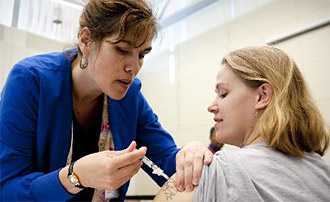
|  |  |  Health & Beauty | December 2009 Health & Beauty | December 2009  
Swine Flu Vaccine Administered to 60 Million in U.S.
 Tom Randall - Bloomberg Tom Randall - Bloomberg
go to original
December 23, 2009


| | About 35 percent of parents in a Harvard survey said they don’t plan to give their children the vaccine, and more than half of adults say they won’t get it. The top reason cited for not getting the shot or nasal spray was concern the vaccine may be unsafe. |  |
At least 60 million Americans have received the swine flu vaccine out of 111 million doses available as of this week, the U.S. Centers for Disease Control and Prevention reported today.

Most states are now offering free inoculations to everyone after first limiting the shots to those most at risk, said Anne Schuchat, head of the CDC’s National Center for Immunization and Respiratory Diseases, on a conference call with reporters. Vaccine availability across the country has been rising, even as illnesses are on the wane, according to the CDC.

Swine flu rates have declined for seven straight weeks and are at their lowest level since pupils returned to classes in September. Flu season in the Northern Hemisphere usually peaks in January and February, and Americans should get the swine flu vaccine to protect against the possibility of resurgence, Schuchat said.

“This is the time to act,” Schuchat said. “Just because people are taking time off for the holidays doesn’t mean this virus will.”

A CDC survey through Dec. 12 found 46 million people had been given the vaccine, and the Atlanta-based agency estimates that 14 million or more may have been vaccinated since then, Schuchat said.

Vaccinated Children

About 74 percent of parents who tried to get their children vaccinated were able to do so, according to a telephone survey conducted last week by the Harvard School of Public Health in Boston. Thirty-eight percent of all parents said their children were vaccinated, and 22 percent of high-risk adults have been inoculated, according to the survey.

Swine flu, or H1N1, infected 50 million people in the U.S. and killed an estimated 10,000 through Nov. 14 from the start of the pandemic in April, the CDC reported Dec. 10. About 36,000 people die each year in the U.S. from influenza.

Swine flu vaccines at first were given only to the most vulnerable people: children, young adults, pregnant women and adults with chronic health conditions. The vaccine is made using the same process as the seasonal flu, and continued monitoring has shown it equally safe and effective, Schuchat said.

About 35 percent of parents in the Harvard survey said they don’t plan to give their children the vaccine, and more than half of adults say they won’t get it. The top reason cited for not getting the shot or nasal spray was concern the vaccine may be unsafe.

Safety Beliefs

“Findings here, like past polls, suggest that beliefs about safety have been difficult to change,” said Robert Blendon, professor of health policy and director of the Harvard Opinion Research Program, in an e-mail. “Now that the H1N1 vaccine is more widely available, public health officials who want to increase vaccination rates will need to focus more attention on convincing people who most need it of its safety.”

Most swine flu infections are no worse than seasonal flu. In rare cases the disease leads to severe illness and death in otherwise health people. Unlike seasonal flu, swine flu disproportionately attacks the young. In a typical flu season, 90 percent of deaths are over age 65; with swine flu, the effects are reversed, with 90 percent of deaths under age 65.

The U.S. ordered 251 million doses of swine flu vaccine, and most states now offer the vaccine to people of all ages. While the shots and nasal sprays are paid for by the U.S. government, clinics can charge a fee to administer them.

Seasonal strains are almost nonexistent in reports from countries where swine flu has taken hold. In the U.S. and Europe, 99 percent of influenza cases tested last week were H1N1, according to government reports. Scientists are split over whether there will be a surge of seasonal flu, swine flu, or no flu at all, according to a Bloomberg survey of eight scientists.

To contact the reporters on this story: Tom Randall in New York at trandall6(at)bloomberg.net |

 |
|  |



